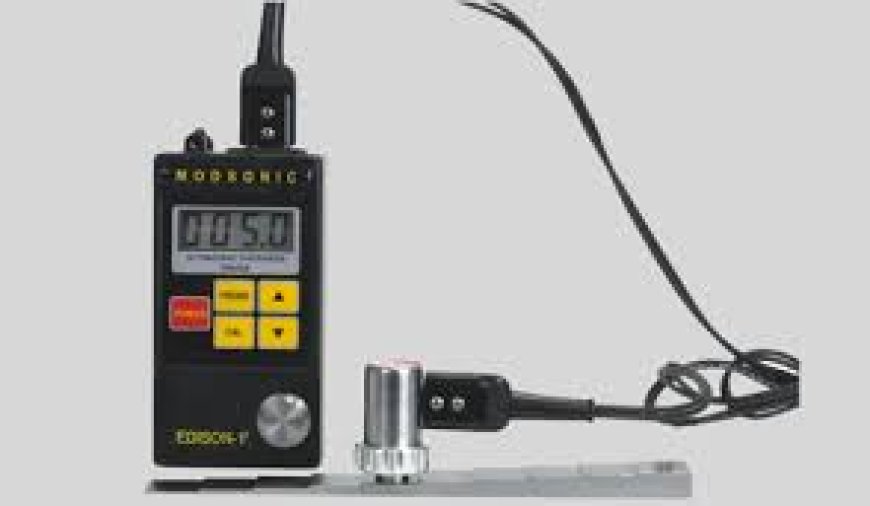The Future of Non-Destructive Testing: Ultrasonic Thickness Testers Explained

Non-destructive testing (NDT) methods have significantly evolved over the years, driven by advancements in technology and increasing demands for safety and reliability across industries. Among these methods, ultrasonic thickness testing stands out as a cornerstone of modern inspection practices. This blog delves into the future of non-destructive testing with a focus on ultrasonic thickness testers, exploring their capabilities, innovations, and potential applications in diverse sectors.
Understanding Ultrasonic Thickness Testing
Ultrasonic thickness testing utilizes high-frequency sound waves to measure the thickness of materials without causing damage. It involves transmitting ultrasonic pulses through the material and analyzing the reflected waves to determine thickness. This non-invasive technique is widely used in industries such as manufacturing, aerospace, marine, and construction for assessing structural integrity and detecting defects like corrosion or erosion.
Innovations Driving the Future of Ultrasonic Thickness Testers
-
Advanced Sensor Technologies: Future ultrasonic thickness tester are expected to feature enhanced sensor technologies that improve measurement accuracy and reliability. These sensors may incorporate multiple transducers for simultaneous measurements or adaptive focusing capabilities for precise detection of thinning areas.
-
Artificial Intelligence (AI) Integration: AI algorithms are poised to revolutionize ultrasonic thickness testing by analyzing complex data patterns and predicting potential material degradation. Machine learning models can enhance defect recognition and assist in predictive maintenance strategies, optimizing asset performance and minimizing downtime.
-
Wireless Connectivity and IoT Integration: The integration of wireless connectivity and Internet of Things (IoT) technologies will enable real-time data streaming and remote monitoring capabilities. Ultrasonic thickness testers equipped with IoT sensors can transmit measurement data to cloud-based platforms for centralized analysis and proactive decision-making.
-
Augmented Reality (AR) and Virtual Reality (VR) Interfaces: AR and VR technologies are expected to enhance user interfaces for ultrasonic thickness testers, providing intuitive visualizations of measurement data overlaid onto physical structures. These immersive interfaces will facilitate easier inspection processes and comprehensive analysis of inspection results.
-
Robotics and Automation: The future of ultrasonic thickness testing may see increased integration with robotic platforms and automated inspection systems. Robots equipped with ultrasonic sensors can navigate complex environments and perform inspections in hazardous or hard-to-reach areas, enhancing safety and efficiency.
Applications of Future Ultrasonic Thickness Testers
-
Smart Infrastructure Monitoring: In the construction and civil engineering sectors, future ultrasonic thickness testers will play a crucial role in monitoring the health of bridges, tunnels, and other infrastructure. Continuous monitoring with IoT-enabled devices will ensure early detection of structural deterioration and facilitate timely repairs.
-
Industry 4.0 and Manufacturing Optimization: Industry 4.0 initiatives will leverage advanced ultrasonic thickness testers for smart manufacturing processes. Real-time monitoring of material thickness during production will ensure quality control and enable predictive maintenance, optimizing production efficiency and reducing waste.
-
Remote and Offshore Inspections: Offshore oil rigs, ships, and remote infrastructure sites will benefit from the portability and connectivity features of future ultrasonic thickness testers. Remote inspection capabilities will minimize travel costs and downtime, while IoT connectivity will enable continuous monitoring of critical assets.
Environmental and Safety Benefits
The adoption of advanced ultrasonic thickness testers will contribute to environmental sustainability and safety across industries:
-
Reduced Material Waste: Accurate thickness measurements prevent premature replacement of components, reducing material waste and environmental impact.
-
Enhanced Safety: Early detection of defects ensures proactive maintenance, minimizing the risk of equipment failures and enhancing workplace safety.
Conclusion
As technology continues to advance, the future of non-destructive testing, particularly ultrasonic thickness testing, promises groundbreaking innovations and transformative applications across industries. From AI-driven analysis and IoT connectivity to AR-enhanced interfaces and robotic inspections, these advancements will redefine how we inspect, maintain, and optimize critical infrastructure and industrial assets.
For professionals and organizations at the forefront of innovation and safety, investing in future-ready "ultrasonic thickness testers" equipped with these technologies will be essential. Embracing these advancements will not only ensure compliance with stringent quality standards but also pave the way for more sustainable and efficient operations in the evolving landscape of non-destructive testing.
What's Your Reaction?


























